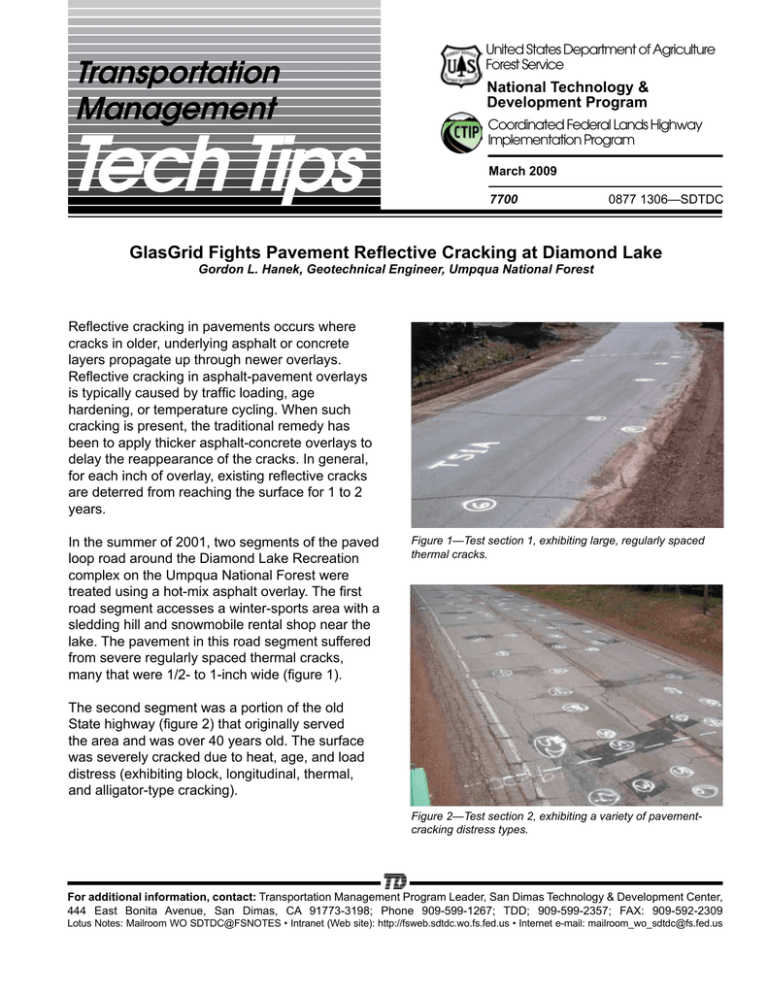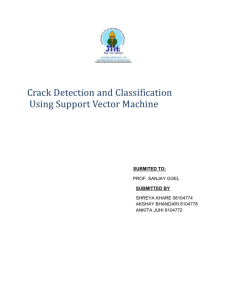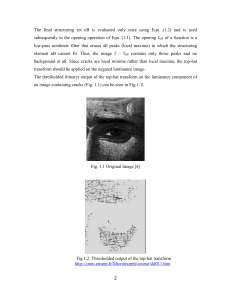Tech Tips Transportation Management National Technology &
advertisement

United States Department of Agriculture Forest Service Transportation Management National Technology & Development Program Tech Tips Coordinated Federal Lands Highway Implementation Program March 2009 7700 0877 1306—SDTDC GlasGrid Fights Pavement Reflective Cracking at Diamond Lake Gordon L. Hanek, Geotechnical Engineer, Umpqua National Forest Reflective cracking in pavements occurs where cracks in older, underlying asphalt or concrete layers propagate up through newer overlays. Reflective cracking in asphalt-pavement overlays is typically caused by traffic loading, age hardening, or temperature cycling. When such cracking is present, the traditional remedy has been to apply thicker asphalt-concrete overlays to delay the reappearance of the cracks. In general, for each inch of overlay, existing reflective cracks are deterred from reaching the surface for 1 to 2 years. Figure 1—Test section 1, exhibiting large, regularly spaced thermal cracks. In the summer of 2001, two segments of the paved loop road around the Diamond Lake Recreation complex on the Umpqua National Forest were treated using a hot-mix asphalt overlay. The first road segment accesses a winter-sports area with a sledding hill and snowmobile rental shop near the lake. The pavement in this road segment suffered from severe regularly spaced thermal cracks, many that were 1/2- to 1-inch wide (figure 1). The second segment was a portion of the old State highway (figure 2) that originally served the area and was over 40 years old. The surface was severely cracked due to heat, age, and load distress (exhibiting block, longitudinal, thermal, and alligator-type cracking). Figure 2—Test section 2, exhibiting a variety of pavementcracking distress types. For additional information, contact: Transportation Management Program Leader, San Dimas Technology & Development Center, 444 East Bonita Avenue, San Dimas, CA 91773-3198; Phone 909-599-1267; TDD; 909-599-2357; FAX: 909-592-2309 Lotus Notes: Mailroom WO SDTDC@FSNOTES • Intranet (Web site): http://fsweb.sdtdc.wo.fs.fed.us • Internet e-mail: mailroom_wo_sdtdc@fs.fed.us 1 Public complaints on the roughness of the surface were common since this segment is one of the main access routes into the large resort and boat-launch complex at the lake. The resort and lake are at an elevation of about 5,000 feet, and both road segments are plowed throughout the winter. As an interim measure—until adequate funding could be obtained for a more comprehensive treatment—a 2-inch, hot-mix overlay was applied to these two road segments in the summer of 2001. As a study, two test sections, one on each overlay segment, were installed using the GlasGrid pavement-reinforcement mesh. This product consists of a series of fiberglass strands knitted together into a mesh and coated with a black-elastomeric polymer. The fiberglass has a high tensile strength and high modulus of elasticity at low elongation (table 1), similar to asphalt-concrete pavement. Table 1—GlasGrid properties Property Test Method Tensile Strength GlasGrid 8501 GlasGrid 8502 560 lbs/in. 560 lbs/in. 1,120 lbs/in. 560 lbs/in. < 3% < 3% ASTM D 6637 Across width Across length Elongation at Break ASTM D 6637 cells, cell A was pretreated with a crack sealer, cell B was pretreated with a crack sealer and GlasGrid, and cell C was a control and not treated. All existing cracks within the cells were mapped and measured prior to treatment. Permanent survey-reference points were established so that the reflected cracks could be related back to preoverlay conditions. Periodic crack surveys were conducted for more than 6 years to measure the reflected cracks. The total length and pattern of reflected cracking through the new overlay were measured and compared with the original pavement condition. The percentage of reflected cracks was calculated, and plots were developed for a comparison between the three cell treatments. When sandwiched between the existing and overlay asphalt courses, GlasGrid is designed to redistribute crack stresses horizontally and dissipate them into the surrounding asphalt mat. The high tensile strength and modulus of elasticity are relatively unique among geosynthetic fabrics used as interlayers in pavements. With these characteristics, it was hoped that the GlasGridtreated sections would demonstrate an improved resistance to reflective cracking with the relatively thin overlay used for this project. Each of the two test sections totaled 300 feet in length and was divided into three 100-foot-long subsections (cells). Within each group of three 2 PAVING The GlasGrid arrived in 5-foot-wide rolls that were spooled off a trailer-hitch device as needed to cover the test-cell cracks (figure 3). The 8501 product is intended for use where cracking is widespread. It was used to cover 100 percent of the cell in test section 2 (figure 5). Figure 3—Placing GlasGrid from the spool, which is attached to a trailer hitch. Figure 5—GlasGrid Type 8501 was applied with 100-percent coverage in test section 2. A 2-inch overlap was used at all seams. The 8502 product is twice as strong in one direction as the other and is intended for use over individual cracks. It was used in test section 1 where the individual-crack treatment was applied (figure 4). GlasGrid comes with a pressure-sensitive adhesive backing that, according to the manufacturer, is sufficient to hold the product in place on fresh asphalt surfaces, such as a leveling course or between overlay lifts. However, since this project was a single 2-inch asphalt lift on older asphalt surfaces without any preleveling, a special quick-set tack was applied prior to placement of the GlasGrid (figure 6). Figure 4—GlasGrid Type 8502 was used to treat the individual thermal cracks in test section 1. The darker areas are those covered by the GlasGrid. Figure 6—A quick-set tack was applied to GlasGrid test cells to ensure good bondage. 3 RESULTS Periodic inspections of all test cells were made over a 6-year period. Average daily traffic counts during this time varied from about 150 to 900, depending on the time of year, and consisted primarily of recreational and administrative vehicles. The site inspections were generally held once in the spring and once in the fall of each year. During each inspection the locations, lengths, orientations, and type of cracks were noted. Photos were taken of any developing reflective cracks as well as the overall site conditions. Table 2 is a summary of the reflective cracking observed in the two test sections. Initial pretreatment-crack types (linear versus area) and lengths are shown for comparison. Linear cracks consisted principally of thermal and longitudinal cracks or other singlecrack features. Area cracking consisted of block and alligator cracking along with areas covered by older geosynthetic patching (see figure 2). A composite-crack length was calculated that sums the linear-crack length and the linear length associated with area cracking to provide a more representative picture of the extent of reflective cracking. This was done since none of the reflective cracking progressed to the point of being “area” cracks during the 6-year observation period (although some linear-reflective cracks did appear over locations with underlying “area” cracking). Table 2 results are shown in figures 9 to 12. Following placement, a light-duty vehicle was used to roll the GlasGrid and seat it securely to the asphalt surface (figure 7). Figure 7—Seating the GlasGrid by rolling with a light-duty vehicle. Paving occurred the same day as the GlasGrid placement, and no problems with grid movement under the paver machine or asphalt-concrete delivery trucks were observed (figure 8). Figure 8—GlasGrid remained bonded to the underlying surface during paving operations. 4 5 A Linear (ft) 215.2 0.0 0.0 0.0 0.0 0.0 0.0 0.0 0.0 0.0 2.5 2.7 2.6 2.8 Area (ft2) 1029.7 0.0 0.0 0.0 0.0 0.0 0.0 0.0 0.0 0.0 0.0 0.0 0.0 0.0 Composite (ft) 622.6 0.0% 0.0% 0.0% 0.0% 0.0% 0.0% 0.0% 0.0% 0.0% 0.4% 0.4% 0.4% 0.5% B Linear (ft) 110.8 0.0 0.0 0.0 0.0 0.0 0.0 0.0 0.0 1.9 4.1 1.3 34.0 46.2 Area (ft2) 1111.0 0.0 0.0 0.0 0.0 0.0 0.0 0.0 0.0 0.0 0.0 0.0 0.0 0.0 Composite (ft) 600.2 0.0% 0.0% 0.0% 0.0% 0.0% 0.0% 0.0% 0.0% 0.3% 0.7% 0.2% 5.7% 7.7% C Linear (ft) 101.5 0.0 0.0 0.0 0.0 0.0 0.0 0.0 0.0 2.7 25.2 26.5 75.0 87.9 Area (ft2) 1425.0 0.0 0.0 0.0 0.0 0.0 0.0 0.0 0.0 0.0 0.0 0.0 0.0 0.0 Composite (ft) 644.0 0.0% 0.0% 0.0% 0.0% 0.0% 0.0% 0.0% 0.0% 0.4% 3.9% 4.1% 11.7% 13.7% A Linear (ft) 162.7 0.0 0.0 0.0 9.9 10.7 11.4 16.0 15.8 16.4 21.1 21.3 34.3 37.2 Area (ft2) 99.7 0.0 0.0 0.0 0.0 0.0 0.0 0.0 0.0 0.0 0.0 0.0 0.0 0.0 Composite (ft) 243.7 0.0% 0.0% 0.0% 4.1% 4.4% 4.7% 6.6% 6.5% 6.7% 8.7% 8.7% 14.1% 15.3% B Linear (ft) 209.4 0.0 0.0 0.0 0.0 0.0 0.0 0.0 0.0 0.9 4.1 3.2 3.9 3.2 Area (ft2) 78.5 0.0 0.0 0.0 0.0 0.0 0.0 0.0 0.0 0.0 0.0 0.0 0.0 0.0 Composite (ft) 287.9 0.0% 0.0% 0.0% 0.0% 0.0% 0.0% 0.0% 0.0% 0.3% 1.4% 1.1% 1.4% 1.1% C Linear (ft) 139.3 0.0 0.0 0.0 13.9 13.9 14.2 21.3 19.3 23.3 37.0 37.5 88.0 88.2 Area (ft2) 94.2 0.0 0.0 0.0 0.0 0.0 0.0 0.0 0.0 0.0 0.0 0.0 0.0 0.0 Composite (ft) 202.3 0.0% 0.0% 0.0% 6.9% 6.9% 7.0% 10.5% 9.5% 11.5% 18.3% 18.5% 43.5% 43.6% Test Section No. 2 Initial Crack Condition Cell Type 6/12/01 4/9/02 7/10/02 10/24/02 4/4/03 6/19/03 9/30/03 3/16/04 4/8/04 11/19/04 6/28/05 9/26/05 5/25/07 11/13/07 Test Section No. 1 Initial Crack Condition Cell Type 6/12/01 4/9/02 7/10/02 10/24/02 4/4/03 6/19/03 9/30/03 3/16/04 4/8/04 11/19/04 6/28/05 9/26/05 5/25/07 11/13/07 Table 2—Reflected Cracking (footage and percentage) Figure 9: Test Section No. 1 50.0% 45.0% Cell A - Crack Sealed Cell B - Glasgrid & Crack Sealed 40.0% Cell C - Control (no pretreatment) Reflective Cracking (%) 35.0% 30.0% 25.0% 20.0% % Reflected Cracking 15.0% 10.0% 5.0% 0.0% 4/9/02 10/24/02 8/19/03 3/16/04 11/19/04 9/28/05 11/13/07 7/10/02 4/4/03 9/30/03 4/8/04 8/28/05 5/25/07 4/9/02 4/4/03 4/8/04 7/10/02 6/19/03 9/30/03 3/16/04 11/19/04 6/28/05 9/26/05 5/25/07 11/13/07 10/24/02 Figure 9—Test section no.1. Figure 10: Test Section No. 2 16.0% 14.0% Cell A - Crack Sealed Cell B - Glasgrid & Crack Sealed Cell C - Control (no pretreatment) Reflective Cracking (%) 12.0% 10.0% 8.0% 6.0% % Reflected Cracking 4.0% 2.0% 0.0% 4/9/02 10/24/02 8/19/03 3/16/04 11/19/04 9/28/05 11/13/07 7/10/02 4/4/03 9/30/03 4/8/04 8/28/05 5/25/07 4/9/02 7/10/02 10/24/02 4/4/03 6/19/03 9/30/03 3/16/04 Figure 10—Test section no.2. 6 4/8/04 11/19/04 6/28/05 9/26/05 5/25/07 11/13/07 Figure 11: Test Section No. 1 50.0% 45.0% 40.0% Reflective Cracking (%) 35.0% Cell A - Crack Sealed Cell B - Glasgrid & Crack Sealed Cell C - Control (no pretreatment) 30.0% 25.0% 20.0% % Reflected Cracking 15.0% 10.0% 5.0% 0.0% 12/1/01 12/1/02 12/1/03 11/30/04 11/30/05 11/30/06 11/30/07 11/29/08 11/30/06 11/30/07 11/29/08 Figure 11—Test section no.1. Figure 12: Test Section No. 2 16.0% 14.0% Reflective Cracking (%) 12.0% Cell A - Crack Sealed Cell B - Glasgrid & Crack Sealed Cell C - Control (no pretreatment) 10.0% 8.0% 6.0% % Reflected Cracking 4.0% 2.0% 0.0% 12/1/01 12/1/02 12/1/03 11/30/04 Figure 12—Test section no.2. 7 11/30/05 The GlasGrid-treated cell in test section 1 (where large, regularly spaced, thermal cracks were the primary distress) has performed significantly better than either the control cell or the cell with only a crack-sealing pretreatment (figures 13 and 14). After 6 years, less than 2 percent of the crack length has reflected through in the GlasGrid section versus almost 45 percent in the control section. Originally, crack severity in test section 1 was generally medium (mean-crack width greater than 1/4 inch) to high (mean-crack width greater than 3/4 inch), whereas all cells after 6 years still have generally low-severity (mean-crack width less than 1/4 inch) cracks though a few medium-severity cracks have developed in the cells without GlasGrid. Reflective cracks are occurring over original cracks that were of medium and high severity. Figure 13—Comparison of reflected crack in GlasGrid-treated cell of test section 1 after 6 years. Figure 14—Comparison of reflected crack in control cell of test section 1 after 6 years. 8 In test section 2, where a variety of crack-distress types including block, alligator, longitudinal, and thermal occurred, the GlasGrid-treated cell experienced less reflective cracking than the control cell but more than the cell with only crack sealing as a treatment. It appears that the GlasGrid was not as successful in retarding the more generally distributed and greater variety of cracking-distress types present in this test section. However, given the relatively small amount of overall reflective cracking that has occurred in test section 2, it may be premature to draw conclusions until additional future observations can be made. As was the case with test section 1, the pretreatment defect-severity in test section 2 was also generally medium. After 6 years, the defect severity in all cells of test section 2 is low (figure 15). Figure 15—Comparison of test-section 2 surface after 6 years. 9 COSTS Current material costs (2008) for the GlasGrid 8501 and 8502 are $0.50 per square foot and $0.64 per square foot, respectively. Installation costs are about $0.08 to $0.11 per square foot. Figure 16 shows the thickness of asphalt that would be a comparable cost to that of GlasGrid, per square foot, where 100-percent coverage is assumed for GlasGrid 8501, and 33-percent coverage (i.e., thermal cracks at 15foot spacing) for GlasGrid 8502. So, the cost of 100 square feet of GlasGrid 8501 would be similar to 100 square feet of asphalt 1.7-inch thick, at $60 per ton. Given the success of GlasGrid 8502 (in this project) at suppressing the reflective cracking of medium-tohigh severity thermal and longitudinal cracks, the selective treatment of individual cracks appears to offer Cost Cmparison of GlasGrid and Asphalt Thickness the greatest potential for life-cycle cost savings when using relatively thin overlays. 4 3.5 3 2.5 8501 8502 2 1.5 Comparable asphalt thickness 1 0.5 0 0 10 20 30 40 50 60 70 80 90 100 Cost of Asphalt ($/ton) Figure 16—The thickness of asphalt that would be comparable to the square-foot cost of GlasGrid, where 100-percent coverage is assumed for GlasGrid 8501, and 33-percent coverage for GlasGrid 8502. 10 CONCLUSIONS Based on monitoring two test sections for 6 years: • GlasGrid 8502 appears to significantly extend the time and reduce the severity of reflected cracks through a 2-inch asphaltconcrete overlay placed over medium-to-high severity thermal and longitudinal cracking when compared to areas without grid reinforcement. ACKNOWLEDGMENTS The author wishes to acknowledge technical reviewers, including Peter Bolander, Forest Service, Region 6; William Vischer, Forest Service, Region 1; and Rene Renteria, Oregon Department of Transportation; as well as San Dimas Technology and Development Center (SDTDC) report editors, and publishers. • The conclusion is less clear for GlasGrid 8501 placed in a test section where other types of pavement distress predominate. SDTDC’s national publications are available on the Internet at: http://www.fs.fed.us/eng/pubs/ Forest Service and U.S. Department of the Interior, Bureau of Land Management employees also can view videos, CDs, and SDTDC’s individual project pages on their internal computer network at: http:// fsweb.sdtdc.wo.fs.fed.us/ • Selective treatment of individual large thermal and longitudinal cracks with GlasGrid 8502 can be a cost-effective technique for minimizing the severity and extending the period of time before reflective cracks reappear through a 2-inch overlay. For additional information on the GlasGrid project, contact Maureen Kestler, project leader, by e-mail: mkestler@fs.fed.us. 11 The information contained in this publication has been developed for the guidance of employees of the Forest Service, U.S. Department of Agriculture, its contractors, and cooperating Federal and State agencies. The Forest Service assumes no responsibility for the interpretation or use of this information by other than its own employees. The use of trade, firm, or corporation names is for the information and convenience of the reader. Such use does not constitute an official evaluation, conclusion, recommendation, endorsement, or approval of any product or service to the exclusion of others that may be suitable. The U.S. Department of Agriculture (USDA) prohibits discrimination in all its programs and activities on the basis of race, color, national origin, age, disability, and where applicable, sex, marital status, familial status, parental status, religion, sexual orientation, genetic information, political beliefs, reprisal, or because all or part of an individual’s income is derived from any public assistance program. (Not all prohibited bases apply to all programs.) Persons with disabilities who require alternative means for communication of program information (Braille, large print, audiotape, etc.) should contact USDA’s TARGET Center at (202) 720-2600 (voice and TDD). To file a complaint of discrimination, write USDA, Director, Office of Civil Rights, 1400 Independence Avenue, S.W., Washington, D.C. 20250-9410, or call (800) 795-3272 (voice) or (202) 720-6382 (TDD). USDA is an equal opportunity provider and employer.







